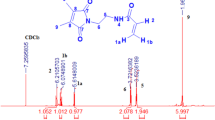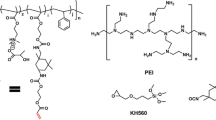Abstract
In this study poly(2-ethyl-2-oxazoline) (PEOXA) chains that contains 11 mol% of benzophenone molecules was synthesized and coated on either 3-ethoxybenzophenonesilane-modified inorganic or bare organic substrates. Upon irradiation under UV light, the photo-active benzophenone molecules enabled the formation of polymer network as well as attachment of the polymer network onto the substrates. Important variables for the generation of hydrogel film with high gel content and stability, such as the heat treatment for solvent removal, the UV wavelength (that determines the irradiation energy), and the input of energy dose were varied and their influence to the gel content and stability of the hydrogel film was studied. The thickness, lifetime of benzophenone, and chemical composition of the film were determined using ellipsometry, UV/Vis spectroscopy, and XPS methods, respectively. On a film that has been exposed to physiological buffer for 14 days, XPS results indicated that chemical degradation of the copolymer did not take place. Ellipsometry results, however, indicated that some portion of the film detached and the remaining thickness was dependent on the input of energy dose during the hydrogel preparation. It was shown that when suitable conditions are applied during preparation, a stable surface-attached PEOXA-based hydrogel, i.e. approximately 78% gel content and 75–90% stability after 30 days of incubation in physiological buffer, could be generated on the surface. Dry and swollen thicknesses of the stable surface-attached film measured from AFM experiments revealed a swelling factor of 1.7. Furthermore, the AFM morphology image showed a homogenous polymer film with an average roughness of 30 nm. Protein adsorption test revealed that the resulting surface-attached PEOXA-based hydrogel film on PMMA substrate hinders BSA adsorption to the same extent as the reference system generated from benzophenone-bearing poly(dimethylacrylamide) (PDMAA).







Similar content being viewed by others
References
Li J, Taylor M, Zhang Z (2017) In: Zhang Z, Wagner V (eds) Anti-fouling medical coatings. Springer, Cham
Chapman RG, Ostuni E, Liang MN, Meluleni G, Kim E, Yan L, Pier G, Warren HS, Whitesides GM (2001) Polymeric thin films that resist the adsorption of proteins and the adhesion of Bacteria. Langmuir 17(4):1225–1233
Hoffmann J, Groll J, Heuts J, Rong H, Klee D, Ziemer G, Moeller M, Wendel HP (2006) Blood cell and plasma protein repellent properties of Star-PEG-modified surfaces. J Biomater Sci Polym Ed 17(9):985–996
Otsuka H, Nagasaki Y, Kataoka K (2004) Characterization of aldehyde-PEG tethered surfaces: influence of PEG chain length on the specific biorecognition. Langmuir 20(26):11285–11287
Mahdavi H, Norouzian S (2018) Preparation and characterization of modified ultrafiltration nylon 6 membrane modified by poly (acrylamide-co-maleic anhydride). J Polym Res 25(10):222
Krsko P, Libera M (2005) Biointeractive hydrogels. Materials Today (Oxford United Kingdom) 8(12):36–44
Koh W-G, Revzin A, Simonian A, Reeves T, Pishko M (2003) BioMEMs materials and fabrication technology: control of mammalian cell and bacteria adhesion on substrates micropatterned with poly(ethylene glycol) hydrogels. Biomed Microdevices 5(1):11–19
Park JH, Bae YH (2003) Hydrogels based on poly(ethylene oxide) and poly(tetramethylene oxide) or poly(dimethyl siloxane). II. Physical properties and bacterial adhesion. J Appl Polym Sci 89(6):1505–1514
Lewis AL (2000) Phosphorylcholine-based polymers and their use in the prevention of biofouling. Colloids Surf B Biointerfaces 18(3,4):261–275
West SL et al (2003) The biocompatibility of crosslinkable copolymer coatings containing sulfobetaines and phosphobetaines. Biomaterials 25(7–8):1195–1204
Li P, Wang J, Lu WC, Sun H, Huang N (2005) Surface characterization and antibacterial evaluation of poly(ethylene terephthalate) modified by chitosan-immobilization. Key Eng Mater 288-289(Advanced Biomaterials VI):331–334
An YH, Farino M, Kang QK, Demcheva MV, Vournakis J (2005) Glucosamine coating for inhibiting bacterial adhesion to titanium surfaces. Key Eng Mater 288-289(Advanced Biomaterials VI):343–346
Morra M, Cassineli C (1999) Non-fouling properties of polysaccharide-coated surfaces. J Biomater Sci Polym Ed 10(10):1107–1124
Tunney MM, Gorman SP (2002) Evaluation of a poly(vinyl pyrrolidone)-coated biomaterial for urological use. Biomaterials 23(23):4601–4608
Koziarz J, Yamazaki H (1999) Stabilization of polyvinyl alcohol coating of polyester cloth for reduction of bacterial adhesion. Biotechnol Tech 13(4):221–225
Chen H, Chen Q, Hu R, Wang H, Newby BMZ, Chang Y, Zheng J (2015) Mechanically strong hybrid double network hydrogels with antifouling properties. J Mater Chem B 3(27):5426–5435
Chen H, Zhao C, Zhang M, Chen Q, Ma J, Zheng J (2016) Molecular understanding and structural-based Design of Polyacrylamides and Polyacrylates as antifouling materials. Langmuir 32(14):3315–3330
Hoogenboom R (2007) Poly(2-oxazoline)s: alive and kicking. Macromol Chem Phys 208(1):18–25
Hoogenboom R (2009) Poly(2-oxazoline)s: a polymer class with numerous potential applications. Angew Chem Int Ed 48(43):7978–7994
Hoogenboom R (2017) 50years of poly(2-oxazoline)s. Eur Polym J 88:448–450
von Erlach T, Zwicker S, Pidhatika B, Konradi R, Textor M, Hall H, Lühmann T (2011) Formation and characterization of DNA-polymer-condensates based on poly(2-methyl-2-oxazoline) grafted poly(l-lysine) for non-viral delivery of therapeutic DNA. Biomaterials 32(22):5291–5303
Pidhatika B, Rodenstein M, Chen Y, Rakhmatullina E, Mühlebach A, Acikgöz C, Textor M, Konradi R (2012) Comparative stability studies of poly(2-methyl-2-oxazoline) and poly(ethylene glycol) brush coatings. Biointerphases 7(1):1–15
Morgese G, Benetti EM (2017) Polyoxazoline biointerfaces by surface grafting. Eur Polym J 88:470–485
Pidhatika B, Möller J, Benetti EM, Konradi R, Rakhmatullina E, Mühlebach A, Zimmermann R, Werner C, Vogel V, Textor M (2010) The role of the interplay between polymer architecture and bacterial surface properties on the microbial adhesion to polyoxazoline-based ultrathin films. Biomaterials 31(36):9462–9472
Chen Y, Pidhatika B, von Erlach T, Konradi R, Textor M, Hall H, Lühmann T (2014) Comparative assessment of the stability of nonfouling poly(2-methyl-2-oxazoline) and poly(ethylene glycol) surface films: An in vitro cell culture study. Biointerphases 9(3):031003
Morgese G, Causin V, Maggini M, Corrà S, Gross S, Benetti EM (2015) Ultrastable suspensions of Polyoxazoline-functionalized ZnO single nanocrystals. Chem Mater 27(8):2957–2964
de la Rosa Victor R et al (2015) Colorimetric logic gates based on poly(2-alkyl-2-oxazoline)-coated gold nanoparticles. Adv Funct Mater 25(17):2511–2519
Mansfield EDH, de la Rosa VR, Kowalczyk RM, Grillo I, Hoogenboom R, Sillence K, Hole P, Williams AC, Khutoryanskiy VV (2016) Side chain variations radically alter the diffusion of poly(2-alkyl-2-oxazoline) functionalised nanoparticles through a mucosal barrier. Biomater Sci 4(9):1318–1327
Koshkina O, Lang T, Thiermann R, Docter D, Stauber RH, Secker C, Schlaad H, Weidner S, Mohr B, Maskos M, Bertin A (2015) Temperature-triggered protein adsorption on polymer-coated nanoparticles in serum. Langmuir 31(32):8873–8881
Zheng X, Zhang C, Bai L, Liu S, Tan L, Wang Y (2015) Antifouling property of monothiol-terminated bottle-brush poly(methylacrylic acid)-graft-poly(2-methyl-2-oxazoline) copolymer on gold surfaces. J Mater Chem B 3(9):1921–1930
Lind JU, Acikgöz C, Daugaard AE, Andresen TL, Hvilsted S, Textor M, Larsen NB (2012) Micropatterning of functional conductive polymers with multiple surface chemistries in register. Langmuir 28(15):6502–6511
Tauhardt L, Frant M, Pretzel D, Hartlieb M, Bücher C, Hildebrand G, Schröter B, Weber C, Kempe K, Gottschaldt M, Liefeith K, Schubert US (2014) Amine end-functionalized poly(2-ethyl-2-oxazoline) as promising coating material for antifouling applications. J Mater Chem B 2(30):4883–4893
Quintana R, Gosa M, Jańczewski D, Kutnyanszky E, Vancso GJ (2013) Enhanced stability of low fouling Zwitterionic polymer brushes in seawater with Diblock architecture. Langmuir 29(34):10859–10867
Divandari M, Dehghani ES, Spencer ND, Ramakrishna SN, Benetti EM (2016) Understanding the effect of hydrophobic protecting blocks on the stability and biopassivity of polymer brushes in aqueous environments: a Tiramis√π for cell-culture applications. Polymer 98:470–480
Pidhatika B, Möller J, Vogel V, Konradi R (2008) Nonfouling surface coatings based on poly(2-methyl-2-oxazoline). CHIMIA Int J Chem 62:264–269
Šrámková P, Zahoranová A, Kroneková Z, Šišková A, Kronek J (2017) Poly(2-oxazoline) hydrogels by photoinduced thiol-ene “click” reaction using different dithiol crosslinkers. J Polym Res 24(5):82
Chang B-J, Prucker O, Groh E, Wallrath A, Dahm M, Rühe J (2002) Surface-attached polymer monolayers for the control of endothelial cell adhesion. Colloids Surf A Physicochem Eng Asp 198-200:519–526
Wang H, Li L, Tong Q, Yan M (2011) Evaluation of Photochemically immobilized poly(2-ethyl-2-oxazoline) thin films as protein-resistant surfaces. ACS Appl Mater Interfaces 3(9):3463–3471
Dorman G, Prestwich GD (1994) Benzophenone photophores in biochemistry. Biochemistry 33(19):5661–5673
Dhende VP, Samanta S, Jones DM, Hardin IR, Locklin J (2011) One-step photochemical synthesis of permanent, nonleaching, ultrathin antimicrobial coatings for textiles and plastics. ACS Appl Mater Interfaces 3(8):2830–2837
Riga KE et al (2017) On the limits of benzophenone as cross-linker for surface-attached polymer hydrogels. Polymers 9(12)
Cui H, Hanus R, Kessler MR (2013) Degradation of ROMP-based bio-renewable polymers by UV radiation. Polym Degrad Stab 98(11):2357–2365
Körner M, Prucker O, Rühe J (2016) Kinetics of the generation of surface-attached polymer networks through C, H-insertion reactions. Macromolecules 49(7):2438–2447
Li K et al (2015) On the lubrication mechanism of surfaces covered with surface-attached hydrogels. Macromol Chem Phys 217(4):526–536
Nakhjiri MT, Bagheri Marandi G, Kurdtabar M (2018) Effect of bis[2-(methacryloyloxy)ethyl] phosphate as a crosslinker on poly(AAm-co-AMPS)/Na-MMT hydrogel nanocomposite as potential adsorbent for dyes: kinetic, isotherm and thermodynamic study. J Polym Res 25(11):244
Pandiyarajan CK, Prucker O, Zieger B, Rühe J (2013) Influence of the molecular structure of surface-attached poly(N-alkyl acrylamide) coatings on the interaction of surfaces with proteins, cells and blood platelets. Macromol Biosci 13(7):873–884
Acknowledgements
We gratefully acknowledge the Alexander von Humboldt foundation for financial support.
Author information
Authors and Affiliations
Corresponding author
Rights and permissions
About this article
Cite this article
Pidhatika, B., Zhao, N. & Rühe, J. Development of surface-attached thin film of non-fouling hydrogel from poly(2-oxazoline). J Polym Res 26, 21 (2019). https://doi.org/10.1007/s10965-018-1677-1
Received:
Accepted:
Published:
DOI: https://doi.org/10.1007/s10965-018-1677-1




